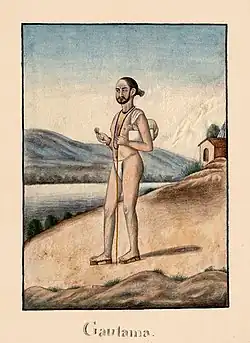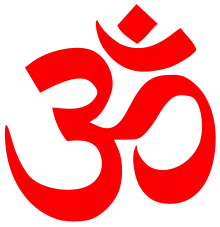Gautama Maharishi | |
|---|---|
 An Early 19th Century Painting Showing Maharishi Gautama | |
| Personal | |
| Religion | Hinduism |
| Spouse | Ahalyā |
| Children | Shatananda and others |
| Honors | One of the Saptarishis (Seven Great Sages Rishi) |
| Part of a series on | |
| Hindu philosophy | |
|---|---|
 | |
| Orthodox | |
|
|
|
| Heterodox | |
|
|
|
Gautama Maharishi (Sanskrit: महर्षिः गौतम, IAST: Maharṣiḥ Gautama), was a sage in Hinduism, who is also mentioned in Jainism and Buddhism. Gautama is mentioned in the Yajurveda, Ramayana, and Gaṇeśa Pūrana and is known for cursing his wife Ahalyā. Another important story related to Gautama is about the creation of river Godavari, which is also known as Gautami.
Children
According to the Ramayana, Gautama's eldest son with Ahalya is Shatananda. But according to the Adi Parva of Mahabharata, he had two sons named Sharadvana and Cirakari. Sharadvana was also known as Gautama, hence his children Kripa and Kripi were called Gautama and Gautami respectively. A daughter of Gautama is referred too, but her name is never disclosed in the epic.[1] In the Sabha Parva, he is described to beget many children through Aushinara (daughter of Ushinara), amongst whom the eldest in Kakshivata. Gautama and Aushinara's wedding takes place at Magadha, the kingdom of Jarasandha.[2] According to the Vamana Purana, he had three daughters named Jaya, Jayanti, and Aparajita.[3]
Gautama is also have said to have fathered Shvetaketu with Uddalaka Aruni in the Brihadaranyaka Upanishad.[4]
Ahalyā's curse

The Gaṇeśa Purāṇa and Ramayana describes Ahalyā as his wife. Their marriage is recorded in the Uttara Khaṇḍa, which is believed as an interpolation to the epic. As per the story Brahma, the creator god, creates a beautiful girl and gifts her as a bride to Gautama and a son named Shatananda is born.
The Upāsanā Khaṇḍa mentions Gautama cursing Indra when he comes home and finds Indra in an argument with his wife. It is revealed that Indra disguised as Gautama had sexual intimacy with Ahalyā and he curses Indra with 1000 vaginas[5] and turns Ahalyā into a stone until Rāma steps on her. Indra is eventually returned to normal after Gautama recites a mantra, and finds greatness in Gaṇeśa that he reveals to the Devas.[5] and Ahalyā is graced by Rāma's foot.
The Bala Khaṇḍa mentions that Gautama spots Indra, who is still in disguise, and curses him to lose his testicles. Gautama then returns to his ashram and accepts her.
Upaniṣads
Gautama is mentioned in two tales inside Bṛhadāraṇyaka Upaniṣad. He speaks to Yajñavalkya with Uddālaka Āruṇi, Gārgī Vāchaknavī and other Kuru and Pañcāla sages in King Janaka's kingdom to test to see if Yajñavalkya is a great sage.[4]
He also has a conversation with Pravāhaṇa Jaivali after Jaivali meets Śvetaketu and requests to meet his father. Jaivali promises to grant Gautama a boon, and describes the beauty and depth of the physical world, and teaches him how to perform yajña.[4]
References
- ↑ "Puranic encyclopaedia: a dictionary with special reference to the epic and Puranic literature". archive.org. 1975.
- ↑ Mahabharata Sabha Parva Section XXI
- ↑ "Puranic encyclopaedia : a dictionary with special reference to epic and Puranic literature". archive.org. 1975.
- 1 2 3 Olivelle, Patrick (2008). Upaniṣads. New York: Oxford University Press. pp. 41, 82–94. ISBN 9780199540259.
- 1 2 Bailey, Greg (2015). The Gaṇeśa Purāṇa: Upāsanā Khaṇḍa vol. 1. New Delhi, India: Motilal Banarsidass Private Publishers Limited. pp. 102–106, 109–110. ISBN 9788120836990.
- Doniger, Wendy (1999). "Indra and Ahalya, Zeus and Alcmena". Splitting the Difference: Gender and Myth in Ancient Greece and India. University of Chicago Press. ISBN 978-0-226-15641-5.